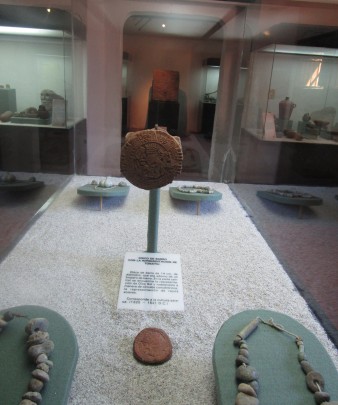Among the important Mexica culture objects on display in the Fray Bernardino de Sahagún Museum, Former Monastery of San Francisco in Tepeapulco there is a slightly convex fragment of a light brown clay brazier which bears an incised sealed solar disc with the image of Tonatiuh, the sun god. It measures five and a half inches in diameter with an average thickness of less than half an inch. It bears traces of red paint. The god wears a headdress consisting of three bands, one on top of the other. The lower is decorated with three small discs, a headdress of Chalchihuites, or jade, characteristic of the god which symbolizes the beauty of the sun, was considered by the Mexica as “the most precious thing existing on the universe and they represented it... as a jewel.” Over the upper band there is a “row of feathers of Tonatiuh” – eight feathers cut at a forward-facing angle, which the archeologist José Corona Núñez interprets as flames. It has a tubular nose ring with the end finished with small jade discs known as yacaxihuitl. The face has two parallel curved lines above the eye which start on the forehead and reach the eyelid, which describe the “arch of the eye.” Eduard Seler described the face of Tonatiuh as having “a red line around the... eye.” The “facial painting typical of the solar deity... includes a semi-circle... which surrounds part of the eye.” The Florentine Codex has imagery of solar and lunar eclipses showing Tonatiuh with three lines around his eye. This is one of his identifying features.
The god appears on the clay disc, surrounded by a circle from which incised triangles representing sun rays emanate above, below and to the sides of the personage, and among these are four oval figures which represent the tip of agave thorns for self-sacrifice, according to the German researcher Hermann Beyer. There is another circle outside the sun rays and the thorns, surrounding the aforementioned elements and in between the two circles there are two, three and four points in relief, and also surrounding it are a series of other points whose number varies between two, four and five; some rectangular projections break this border, and with the points, they may represent a solar count. The philologist Cecilio A. Robelo, who has studied Nahuatl, says that the Mexicans represented the sun with several concentric circles divided into eight parts with some rectangular blades related to the apparent movement of the star and the division of time.
Tonatiuh is in profile and seems to be running, since one foot is on the ground, while the other points backwards and is raised at a right angle. The arms are forward facing, the right faces upwards grasping a dart thrower, and the left arm is horizontal holding two darts finished with feathers and with triangular tips. He also carries a little bag, maybe for copal, decorated with an incised grid pattern. These weapons show that Tonatiuh was the patron of war and of warriors. The archeologist Alfonso Caso says that according to Mexica philosophy, “the sun and warfare... are necessary partners... since the sun needs human blood and hearts provided to it by sacrifice, and in turn sacrifice requires war.” The sun rises radiant every morning in the east and it launches the arrow cuezalmamaziomitl at its enemies, the moon and the stars, to put them to flight. Eagles and tigers also had this attitude, and they too served the sun.
When the sun rose every day, the Mexica would receive it with music from drums, flutes and shells, and they made sacrifices and sacrificed themselves, they would bleed their ears and throw their blood to the sun. They also decapitated quails. They believed that for four years, before turning into hummingbirds, the rising sun was received and carried on a litter through the sky by the souls of warriors who died in combat or on the sacrificial stone, who would beat their shields heartily as they sang war songs. When they reached the sun’s zenith, their place was taken by the cihuateteo, or women who died in childbirth, who would take the sun to its setting point on a litter of feathers from the quetzal and from other beautiful birds.
The Relación de Tepeapulco, which was written at the command of King Philip II of Spain in the earliest years of the colony, states that the principal god of these peoples was Huitzilopochtli, the Aztec or Mexica god of war, who could be confused with Tonatiuh. Alfonso Caso even concluded that Huitzilopochtli was synonymous with the sun, but the ethno-historian Yólotl Gonzáles makes the distinction that though he was related to the sun, he himself was not the solar deity. In reality he was the guiding chieftain of the Aztecs who came from Aztlán and who “were told by the ancient god Tetzauhteotl to offer hearts to Ollin Tonatiuh (the movement of the sun).” The leader was deified after his death and became a sun god. The “principal connection between Huitzilopochtli and the sun is as the god of war, since this was how captives were procured to be offered to the sun.” The warrior was responsible for providing the sun with victims, he was the supplier to the sun, and should not be confused with it.
The clay disc in the Tepeapulco museum is a fragment of a ceremonial brazier used in the worship of Tonatiuh, and its rightful place was in the Cuauhcalli (House of the Eagles), which was the temple dedicated to the sun. It forms part of Mexica culture which occupied this part of Hidalgo in the fourteenth and fifteenth centuries AD.








